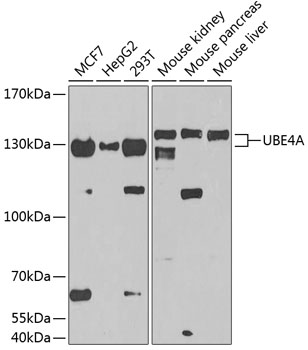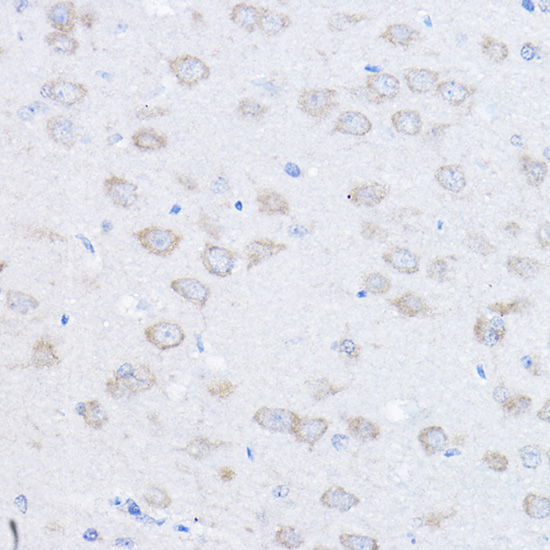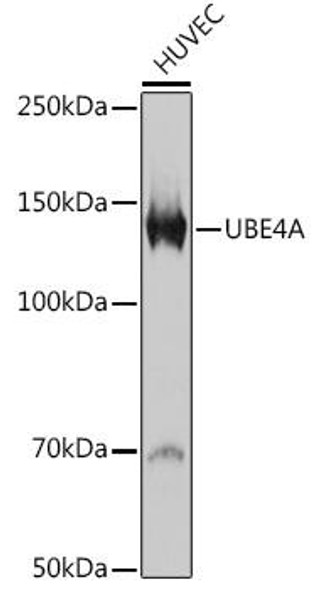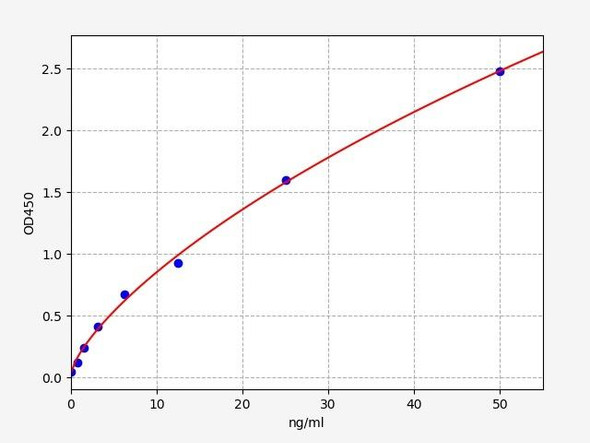Signal Transduction Antibodies 2
Anti-UBE4A Antibody (CAB3354)
- SKU:
- CAB3354
- Product Type:
- Antibody
- Reactivity:
- Human
- Reactivity:
- Mouse
- Reactivity:
- Rat
- Host Species:
- Rabbit
- Isotype:
- IgG
- Research Area:
- Signal Transduction
Description
| Antibody Name: | Anti-UBE4A Antibody |
| Antibody SKU: | CAB3354 |
| Antibody Size: | 20uL, 50uL, 100uL |
| Application: | WB IHC |
| Reactivity: | Human, Mouse, Rat |
| Host Species: | Rabbit |
| Immunogen: | Recombinant fusion protein containing a sequence corresponding to amino acids 797-1066 of human UBE4A (NP_001191006.1). |
| Application: | WB IHC |
| Recommended Dilution: | WB 1:500 - 1:2000 IHC 1:50 - 1:200 |
| Reactivity: | Human, Mouse, Rat |
| Positive Samples: | MCF7, HepG2, 293T, Mouse kidney, Mouse pancreas, Mouse liver |
| Immunogen: | Recombinant fusion protein containing a sequence corresponding to amino acids 797-1066 of human UBE4A (NP_001191006.1). |
| Purification Method: | Affinity purification |
| Storage Buffer: | Store at -20'C. Avoid freeze / thaw cycles. Buffer: PBS with 0.02% sodium azide, 50% glycerol, pH7.3. |
| Isotype: | IgG |
| Sequence: | FLLD EAIQ YLSK IKIQ QIEK DRGE WDSL TPEA RREK EAGL QMFG QLAR FHNI MSNE TIGT LAFL TSEI KSLF VHPF LAER IISM LNYF LQHL VGPK MGAL KVKD FSEF DFKP QQLV SDIC TIYL NLGD EENF CATV PKDG RSYS PTLF AQTV RVLK KINK PGNM IMAF SNLA ERIK SLAD LQQQ EEET YADA CDEF LDPI MSTL MCDP VVLP SSRV TVDR STIA RHLL SDQT DPFN RSPL TMDQ IRPN TELK EKIQ RWLA ERKQ QKEQ LE |
| Gene ID: | 9354 |
| Uniprot: | Q14139 |
| Cellular Location: | Cytoplasm |
| Calculated MW: | 122kDa/123kDa |
| Observed MW: | 130kDa |
| Synonyms: | UBE4A, E4, UBOX2, UFD2 |
| Background: | This gene encodes a member of the U-box ubiquitin ligase family. The encoded protein is involved in multiubiquitin chain assembly and plays a critical role in chromosome condensation and separation through the polyubiquitination of securin. Autoantibodies against the encoded protein may be markers for scleroderma and Crohn's disease. A pseudogene of this gene is located on the long arm of chromosome 3. Alternatively spliced transcript variants encoding multiple isoforms have been observed for this gene. |
| UniProt Protein Function: | UBE4A: Binds to the ubiquitin moieties of preformed conjugates and catalyzes ubiquitin chain assembly in conjunction with E1, E2, and E3. Belongs to the ubiquitin conjugation factor E4 family. 2 isoforms of the human protein are produced by alternative splicing. |
| UniProt Protein Details: | Protein type:EC 6.3.2.-; Ubiquitin conjugating system; EC 6.3.2.19; Ligase; Ubiquitin ligase Chromosomal Location of Human Ortholog: 11q23.3 Cellular Component: cytoplasm; ubiquitin ligase complex Molecular Function:protein binding; ligase activity Biological Process: ubiquitin-dependent protein catabolic process; protein polyubiquitination |
| NCBI Summary: | This gene encodes a member of the U-box ubiquitin ligase family. The encoded protein is involved in multiubiquitin chain assembly and plays a critical role in chromosome condensation and separation through the polyubiquitination of securin. Autoantibodies against the encoded protein may be markers for scleroderma and Crohn's disease. A pseudogene of this gene is located on the long arm of chromosome 3. Alternatively spliced transcript variants encoding multiple isoforms have been observed for this gene. [provided by RefSeq, Feb 2011] |
| UniProt Code: | Q14139 |
| NCBI GenInfo Identifier: | 71164791 |
| NCBI Gene ID: | 9354 |
| NCBI Accession: | Q14139.2 |
| UniProt Secondary Accession: | Q14139,Q2M1H0, Q6P5T4, Q7Z639, B0YJB6, |
| UniProt Related Accession: | Q14139 |
| Molecular Weight: | 1066 |
| NCBI Full Name: | Ubiquitin conjugation factor E4 A |
| NCBI Synonym Full Names: | ubiquitination factor E4A |
| NCBI Official Symbol: | UBE4A |
| NCBI Official Synonym Symbols: | E4; UFD2; UBOX2 |
| NCBI Protein Information: | ubiquitin conjugation factor E4 A; ubiquitination factor E4A (UFD2 homolog, yeast) |
| UniProt Protein Name: | Ubiquitin conjugation factor E4 A |
| Protein Family: | Ubiquitin conjugation factor |
| UniProt Gene Name: | UBE4A |
| UniProt Entry Name: | UBE4A_HUMAN |
View AllClose








